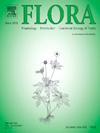Surviving the extinction vortex? Discovering remnant stands of Senecio hercynicus (Compositae, Senecioneae) evading genetic swamping by its congener S. ovatus in the Bavarian and Bohemian Forest region
Abstract
Genetic swamping by introgressive hybridisation threatens diversity, caused by climate warming particularly in mountainous regions worldwide. Recent studies resulted in a threatening perspective for Senecio hercynicus in the Bavarian Forest due to genetic swamping by introgressive hybridisation with its cogener S. ovatus. To examine the situation more closely, the distribution and hybridization of S. hercynicus and S. ovatus in high elevation regions of the Bavarian and Bohemian Forest was analyzed by restriction enzyme digestion of nrDNA ITS1 (PCR-RFLP; PCR restriction fragment length polymorphism). For a total of 706 samples from 94 different sample localities a hybrid index was inferred from the fragment band intensities after PCR-RFLP digestion. Boxplot diagrams of the hybrid indices show a tendency of western populations towards S. ovatus genotypes and for populations to the east towards S. hercynicus genotypes. When the hybrid index data was subjected to a regression analysis with nine factors (five habitat patterns inferred during sampling and four bioclimatic variables), only geographical longitude and latitude seemed to describe the observed distribution of S. hercynicus and S. ovatus significantly, arguing for the distribution and hybridisation patterns being shaped rather due to historical than to eco-climatological determinants. While a broad zone of hybridisation between the two species in the Bavarian and Bohemian Forest region was inferred, our study demonstrates that purebred S. hercynicus still exists and remnant stands of this species should be the target of species conservation measures.

 求助内容:
求助内容: 应助结果提醒方式:
应助结果提醒方式:


